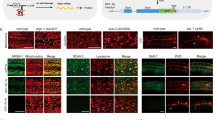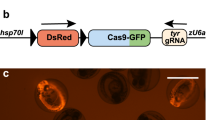Abstract
We developed a method, MosDEL, to generate targeted knockouts of genes in Caenorhabditis elegans by injection. We generated a double-strand break by mobilizing a Mos1 transposon adjacent to the region to be deleted; the double-stranded break is repaired using injected DNA as a template. Repair can delete up to 25 kb of DNA and simultaneously insert a positive selection marker.
This is a preview of subscription content, access via your institution
Access options
Subscribe to this journal
Receive 12 print issues and online access
$259.00 per year
only $21.58 per issue
Buy this article
- Purchase on Springer Link
- Instant access to full article PDF
Prices may be subject to local taxes which are calculated during checkout


Similar content being viewed by others
Change history
06 May 2010
In the version of this article initially published online, the statement that MosDEL can delete 10,069 of 10,154 genes presently lacking a deletion allele was an underestimate; 15,072 of the 15,157 genes presently lacking a publicly available deletion allele can be deleted by MosDEL. Also, the species origin of the Mos1 transposon was incorrect and the abbreviation for Mos1 excision-induced transgene-instructed gene conversion was incorrect. These errors have been corrected online for the print, PDF and HTML versions of this article.
References
Moerman, D.G. & Barstead, R.J. Brief. Funct. Genomics Proteomics 7, 195–204 (2008).
Pontier, D.B., Kruisselbrink, E., Guryev, V. & Tijsterman, M. Nat. Methods 6, 655–657 (2009).
Gengyo-Ando, K. & Mitani, S. Biochem. Biophys. Res. Commun. 269, 64–69 (2000).
Ryder, E. et al. Genetics 177, 615–629 (2007).
Berezikov, E., Bargmann, C.I. & Plasterk, R.H.A. Nucleic Acids Res. 32, e40 (2004).
Zwaal, R.R., Broeks, A., van Meurs, J., Groenen, J.T. & Plasterk, R.H. Proc. Natl. Acad. Sci. USA 90, 7431–7435 (1993).
Robert, V. & Bessereau, J. EMBO J. 26, 170–183 (2007).
Bazopoulou, D. & Tavernarakis, N. Genetica 137, 39–46 (2009).
Plasterk, R.H. & Groenen, J.T. EMBO J. 11, 287–290 (1992).
Frøkjaer-Jensen, C. et al. Nat. Genet. 40, 1375–1383 (2008).
Gloor, G.B., Nassif, N.A., Johnson-Schlitz, D.M., Preston, C.R. & Engels, W.R. Science 253, 1110–1117 (1991).
Maydan, J.S. et al. Genome Res. 17, 337–347 (2007).
Keeler, K.J., Dray, T., Penney, J.E. & Gloor, G.B. Mol. Cell. Biol. 16, 522–528 (1996).
Bessereau, J.L. et al. Nature 413, 70–74 (2001).
Harris, T.W. et al. Nucleic Acids Res. 38, 463–467 (2010).
Acknowledgements
We thank L. Segalat (Centre National de la Recherche Scientifique, Lyon, France) and members of the NemaGENETAG consortium for Mos1 strains. C.F.-J. is funded by a fellowship from the Lundbeck Foundation and G.H. by a Jane Coffin Childs fellowship funded by Howard Hughes Medical Institute. M.B. is funded by a McKnight Grant. D.G.M. is funded by Genome Canada and Genome British Columbia.
Author information
Authors and Affiliations
Contributions
C.F.-J., M.W.D., G.H. and E.M.J. conceived and designed experiments; C.F.-J., G.H., J.T., P.N., R.L. and M.P.-D. performed experiments; T.W.H. performed the bioinformatic analysis of Mos1 distribution; M.B., D.G.M. and E.M.J. provided supervision and funding; C.F.-J. and E.M.J. wrote the manuscript.
Corresponding author
Ethics declarations
Competing interests
E.M.J. is the author of a patent covering techniques described in this paper (US patent 7,196,244 and European patent pending). T.W.H. is the sole proprietor of Hi-Line Informatics.
Supplementary information
Supplementary Text and Figures
Supplementary Figures 1–2 and Supplementary Tables 1,3 (PDF 1698 kb)
Supplementary Table 2
Mos1 distribution. (XLS 12467 kb)
Rights and permissions
About this article
Cite this article
Frøkjær-Jensen, C., Davis, M., Hollopeter, G. et al. Targeted gene deletions in C. elegans using transposon excision. Nat Methods 7, 451–453 (2010). https://doi.org/10.1038/nmeth.1454
Received:
Accepted:
Published:
Issue Date:
DOI: https://doi.org/10.1038/nmeth.1454
This article is cited by
-
Using genetics to understand biology
Heredity (2019)
-
Genome-Wide Determination of Gene Essentiality by Transposon Insertion Sequencing in Yeast Pichia pastoris
Scientific Reports (2018)
-
Targeted genome engineering in Caenorhabditis elegans
Cell & Bioscience (2016)
-
An instructive role for C. elegans E-cadherin in translating cell contact cues into cortical polarity
Nature Cell Biology (2015)
-
C. elegans Punctin specifies cholinergic versus GABAergic identity of postsynaptic domains
Nature (2014)



